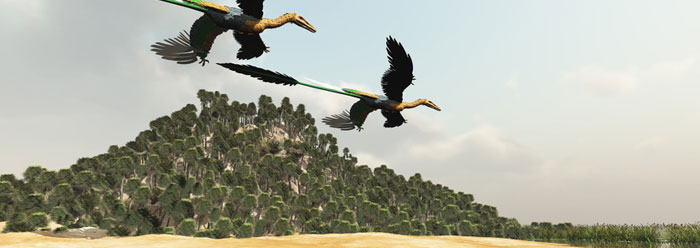This was such a rare find because the creature apparently did not have enough time to digest its food before it was killed and subsequently fossilized. The still-connected bones of the eaten bird's feet enabled paleontologists to positively identify it. The creature that ate the bird, however, proved more difficult to classify.
In a report published in the Proceedings of the National Academy of Sciences, three investigators wrote that the fossilized predator was the four-winged flying creature Microraptor gui, already known from other fossils.1 Since the species was described in 2000, it has been the subject of evolution-based speculation, including ongoing confusion over what its name should be, under what category it should be grouped, what role it may or may not have played in the imaginary evolutionary drama, and even what general class of animal it was.
Microraptor had long flight feathers on its hind legs, and no such creature inhabits modern zoos. However, the fact that it had flight feathers should have been a major clue as to its basic identity. Only birds sport feathers. It also had a long tail with flattened flight feathers on the end. Such a tail would have stabilized—and was perhaps essential to—a creature with four operational wings. The skeletal anatomy and presence of flight feathers clearly show that Microraptor was a bird, albeit a unique one.
So the evolutionary doctrine that dinosaurs evolved into birds must be the main reason why scientists labeled Microraptor a theropod dinosaur, rather than the scientific evidence. By first calling this creature a dinosaur, they can then point to it as an example of a so-called "feathered dinosaur!"
Not only have evolutionists blurred the meaning of the word "dinosaur" and failed to identify Microraptor as a bird, some have also suggested that Microraptor was the evolutionary link connecting dinosaurs to birds.2
This new fossil, however, refutes that idea and reinforces the conclusion that this creature was a bird. First, if Microraptor was evolving from a dinosaur into a more modern-looking bird, then why was a regular two-winged bird found in its rib cage—obviously co-existing with the Microraptor before it became lunch?
Also, if Microraptor was transitioning from a land-dwelling dinosaur into a tree-dwelling bird, then why was it already so well-formed that it could successfully hunt, kill, and eat fully formed flying birds? The PNAS authors wrote, "The fact the enantiornithine [the eaten bird] was an adult also suggests that Microraptor was capable of active hunting and was a fairly agile predator."1 Obviously, Microraptor was a capable flyer, not a half-evolved pre-bird.
Birds prey on other birds today, and fossils show that they did the same in the past. However, dinosaurs are not known to have eaten birds, since birds could presumably have evaded the ground-dwelling dinosaurs by flying away. Since most dinosaurs couldn't reach birds, the PNAS authors remarked that "this report of a dinosaur feeding on birds is unique."1 But it's only unique if the definition of "dinosaur" includes birds!
This fossilized creature swallowed its prey headfirst, "as in most living predatory birds." Microraptor "was spending a substantial amount of time in the trees" because that's where birds, not dinosaurs, lived.1 "Microraptor also had bird teeth and not dinosaur teeth, reinforcing this view."3
This fossils shows that Microraptor probably was not flightless, nevertheless "some researchers now embrace the idea that the small 'theropod dinsoaurs' with true feathers, especially Microraptor, are really birds, probably flightless."3
The new evidence of Microraptor's predatory flight capability clearly shows that it was a four-winged bird, not a dinosaur—and not an evolutionary transition.
References
- O'Connor, J., Z. Zhou, and X. Xu. 2011. Additional specimen of Microraptor provides unique evidence of dinosaurs preying on birds. Proceedings of the National Academy of Sciences. 108 (49): 19662-19665..
- Norell, M. et al. 2002. Palaeontology: 'Modern' feathers on a non-avian dinosaur. Nature. 416 (6876): 36.
- Oard, M. 2011. Did birds evolve from dinosaurs? Journal of Creation. 25 (2): 22-31.
* Mr. Thomas is Science Writer at the Institute for Creation Research.
